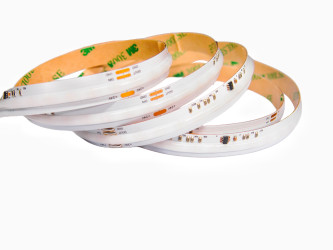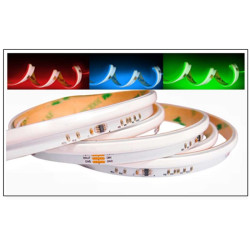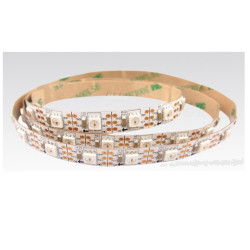SPI (Digital) LED Strip
Digital LED strip lights are revolutionizing the way we illuminate our environments. These flexible strips feature individually controllable LEDs, powered by integrated microchips that enable a variety of lighting effects. Available in several types, such as RGB, RGBW, and RGBCCT, they cater to diverse aesthetic preferences while ensuring energy efficiency.
Digital LED Strip Lights
One of the standout traits of digital LED strips is their remarkable versatility. You can easily trim them to your desired length, making them ideal for custom installations in homes, commercial spaces, and even outdoor settings. For added convenience, waterproof options are also available, enhancing their durability and adaptability. Whether you’re looking to create:
-
subtle under-cabinet lighting,
-
highlight specific features in your garden,
-
or provide ambient lighting for events,
-
these strips deliver exceptional results.
With an impressive lifespan of around 50,000 hours, many of these LED strips also carry a UL Listing, which assures compliance with safety standards. They boast advanced capabilities like:
-
adjustable brightness,
-
eye-catching animations,
-
and smooth color transitions,
making them perfect for creative endeavors, events, or creating the perfect ambiance.
Installation is a breeze thanks to a variety of available accessories, including:
-
LED controllers,
-
power supplies,
-
connectors,
-
diffusers,
-
and mounting clips,
all of which enhance functionality and simplify the setup process.
For those looking to elevate their experience, smart LED technology allows for remote control and automation via compatible apps and devices.
In essence, digital LED strip lights offer a vibrant and energy-efficient lighting solution that serves both practical and aesthetic needs. Perfect for any indoor or outdoor application, they provide unmatched flexibility and potential for creativity.
What Are Digital Pixel LED Strips and How Do They Work?
Digital pixel LED strips are a unique kind of addressable LED strip that incorporate integrated circuits like WS2811, WS2812B, or SK6812. This design allows for individual control of each pixel, with a pixel usually consisting of multiple LEDs—typically three for standard RGB configurations or up to six when including white. These strips can be easily customized; they can be cut along specific marked lines and are connected using JST connectors or jumper wires.
They run on protocols such as SPI or DMX512, receiving data from controllers like Arduino, Raspberry Pi, or BeagleBone Black. The microcontrollers send precise PWM signals to regulate brightness and color, leading to vibrant lighting effects, including color chasing and dynamic animations. The state of each LED is stored in memory, ensuring smooth transitions and uninterrupted performance.
The extensive range of RGB color combinations makes these strips incredibly adaptable, suitable for a variety of creative projects, including:
-
artistic installations,
-
commercial lighting solutions,
-
distinctive lighting sequences.
Additionally, these flexible strips are often mounted on copper PCBs that utilize thermal management adhesives, effectively dissipating heat and enhancing durability.
Thanks to these advanced features, digital pixel LED strips significantly elevate visual experiences across various environments. Their precise pixel control is ideal for everything from stage settings to architectural illumination and video displays. Beyond their visual appeal, these programmable LED strips also serve practical lighting purposes, whether they're used indoors or outdoors.
When it comes to choosing between 24V and 12V digital LED strips, the 24V versions bring several advantages, particularly in terms of efficiency and overall performance.
-
Higher voltage strips consume less current,
-
diminished voltage drop over longer runs,
-
consistent brightness and color,
-
enhanced efficiency,
-
better heat management.
This means users can enjoy extended operational periods without compromising on performance. Additionally, these strips are often compatible with a broader array of power supplies, providing more installation flexibility and ensuring dependable operation.
Why Choose 24V Digital LED Strips Over 12V Versions?
Opting for 24V LED strips comes with a host of advantages, especially when stacked against the traditional 12V options. One of the standout benefits is the longer maximum run length. The enhanced voltage of 24V helps reduce voltage drop, enabling installations to stretch further without compromising brightness. This attribute is particularly beneficial for expansive lighting needs, such as those found in commercial and architectural settings.
When it comes to energy efficiency, 24V strips outshine their 12V counterparts. They use less power to achieve the same luminosity, making them a smart choice for larger installations without inflating energy bills. Additionally, thanks to their construction and materials—often utilizing copper in the PCB—these strips excel in heat management. This minimizes overheating risks and contributes to a safer, more dependable operation.
For projects that demand high-density LED configurations, 24V strips shine. They accommodate a larger number of LEDs along a given length, achieving a consistent brightness across wide areas. This capability is crucial for intricate lighting designs where uniform illumination is necessary.
Furthermore, 24V strips are incredibly adaptable, working seamlessly with appropriate LED power supplies, controllers, and customizable features to create tailored lighting solutions. The installation process is also made easier by the variety of mounting clips and profiles available.
In terms of aesthetic flexibility, both 12V and 24V strips offer dimming capabilities and an array of color choices. However, 24V strips generally deliver superior performance, making them ideal for more demanding applications. Their resilience and longevity further enhance their appeal, providing lighting solutions that remain effective over time.
How Does RGB+W Technology Enhance Your Lighting Experience?
RGB+W technology significantly enriches your lighting experience by integrating a unique white LED channel alongside the standard red, green, and blue (RGB) settings. This enhancement allows for improved color precision and brightness regulation, resulting in stunning visual effects. Users will appreciate a wider array of colors and the ability to create pure white light without any tint, making RGBW strips perfect for environments that require both vivid hues and natural illumination.
Within this technology, you’ll find options like RGBCCT strips, which feature adjustable cool and warm white LEDs. These capabilities allow you to effortlessly adapt the ambiance to suit different activities. Whether you need bright white light to focus on work or a cozy warm glow for relaxation, RGBW technology seamlessly accommodates all your lighting needs.
-
Versatile lighting effects including color chasing and personalized sequences,
-
Capability to craft billions of color combinations,
-
Elegant lighting solutions for both residential and commercial settings,
-
Ability to dim the lights and create smooth transitions,
-
Cutting-edge digital LED strip technology for easy control.
With the capability to craft billions of color combinations, you can completely transform any space. These features make RGBW technology an outstanding choice for a variety of lighting applications, merging functionality with artistic expression. Installation is straightforward, aided by an array of compatible accessories that simplify usage and provide greater control over your lighting design.
What Are Smart Control Features Available for Pixel LED Strip Lighting?
Smart control options for pixel LED strip lighting provide exciting functionality and a wealth of customization choices that significantly enrich the user’s experience. With the help of innovative LED controllers like the Leona® Digital Controller and the Magic-LED Bluetooth Controller, these features come to life.
These advanced controllers support various communication protocols such as SPI, DMX512, and Art-Net, enabling users to have precise pixel-level control. This level of detail allows for the creation of stunning light animations and effects, which can even sync with music or video content. Consequently, visual presentations for events or exhibitions are enhanced dramatically.
Microcontrollers like Arduino, ESP32, and Raspberry Pi are also essential for automating and personalizing lighting effects. Equipped with specialized software for LED strips, these microcontrollers facilitate the design of unique lighting sequences, significantly expanding the potential of digital LED strips. Users can explore options such as WLED or LED Strip Studio to create truly one-of-a-kind lighting experiences.
Additionally, accessories like signal splitters and data range extenders offer improved installation versatility and scalability. These tools help maintain strong signal integrity over longer distances and complicated setups, making the overall installation process much simpler.
Notable smart features include:
-
dimming options,
-
color temperature adjustments,
-
sound-reactive modes,
-
programmable sequences,
-
customizable light animations.
Such capabilities enable users to modify their lighting according to the atmosphere or activity. Furthermore, programmable sequences elevate the experience, ensuring that pixel LED strip lighting is ideal for imaginative installations in both residential and commercial settings.
In the end, these smart control features transform ordinary lighting arrangements into vibrant displays. They foster deeper engagement and personalization across a wide range of environments, enhancing everything from home décor to entertainment venues.



